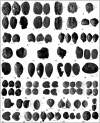Altered cropping pattern and cultural continuation with declined prosperity following abrupt and extreme arid event at ~4,200 yrs BP: Evidence from an Indus archaeological site Khirsara, Gujarat, western India
- PMID: 28985232
- PMCID: PMC5630146
- DOI: 10.1371/journal.pone.0185684
Altered cropping pattern and cultural continuation with declined prosperity following abrupt and extreme arid event at ~4,200 yrs BP: Evidence from an Indus archaeological site Khirsara, Gujarat, western India
Abstract
Archaeological sites hold important clues to complex climate-human relationships of the past. Human settlements in the peripheral zone of Indus culture (Gujarat, western India) are of considerable importance in the assessment of past monsoon-human-subsistence-culture relationships and their survival thresholds against climatic stress exerted by abrupt changes. During the mature phase of Harappan culture between ~4,600-3,900yrsBP, the ~4,100±100yrsBP time slice is widely recognized as one of the major, abrupt arid-events imprinted innumerous well-dated palaeo records. However, the veracity of this dry event has not been established from any archaeological site representing the Indus (Harappan) culture, and issues concerning timing, changes in subsistence pattern, and the likely causes of eventual abandonment (collapse) continue to be debated. Here we show a significant change in crop-pattern (from barley-wheat based agriculture to 'drought-resistant' millet-based crops) at ~4,200 yrs BP, based on abundant macrobotanical remains and C isotopes of soil organic matter (δ13CSOM) in an archaeological site at Khirsara, in the Gujarat state of western India. The crop-change appears to be intentional and was likely used as an adaptation measure in response to deteriorated monsoonal conditions. The ceramic and architectural remains of the site indicate that habitation survived and continued after the ~4,200yrsBP dry climatic phase, but with declined economic prosperity. Switching to millet-based crops initially helped inhabitants to avoid immediate collapse due to climatic stresses, but continued aridity and altered cropping pattern led to a decline in prosperity levels of inhabitants and eventual abandonment of the site at the end of the mature Harappan phase.
Conflict of interest statement
Figures





Similar articles
-
Oxygen isotope in archaeological bioapatites from India: Implications to climate change and decline of Bronze Age Harappan civilization.Sci Rep. 2016 May 25;6:26555. doi: 10.1038/srep26555. Sci Rep. 2016. PMID: 27222033 Free PMC article.
-
Stable isotope and dental caries data reveal abrupt changes in subsistence economy in ancient China in response to global climate change.PLoS One. 2019 Jul 22;14(7):e0218943. doi: 10.1371/journal.pone.0218943. eCollection 2019. PLoS One. 2019. PMID: 31329608 Free PMC article.
-
Drought stress variability in ancient Near Eastern agricultural systems evidenced by δ13C in barley grain.Proc Natl Acad Sci U S A. 2014 Aug 26;111(34):12348-53. doi: 10.1073/pnas.1409516111. Epub 2014 Aug 11. Proc Natl Acad Sci U S A. 2014. PMID: 25114225 Free PMC article.
-
Cultural responses to climate change during the late Holocene.Science. 2001 Apr 27;292(5517):667-73. doi: 10.1126/science.1059827. Epub 2001 Apr 12. Science. 2001. PMID: 11303088 Review.
-
Soil analysis in discussions of agricultural feasibility for ancient civilizations: A critical review and reanalysis of the data and debate from Chaco Canyon, New Mexico.PLoS One. 2018 Jun 14;13(6):e0198290. doi: 10.1371/journal.pone.0198290. eCollection 2018. PLoS One. 2018. PMID: 29902207 Free PMC article. Review.
Cited by
-
Sex-Biased Population Admixture Mediated Subsistence Strategy Transition of Heishuiguo People in Han Dynasty Hexi Corridor.Front Genet. 2022 Mar 10;13:827277. doi: 10.3389/fgene.2022.827277. eCollection 2022. Front Genet. 2022. PMID: 35356424 Free PMC article.
-
Intensified summer monsoon and the urbanization of Indus Civilization in northwest India.Sci Rep. 2018 Mar 9;8(1):4225. doi: 10.1038/s41598-018-22504-5. Sci Rep. 2018. PMID: 29523797 Free PMC article.
-
The "2.8 ka BP Cold Event" Indirectly Influenced the Agricultural Exploitation During the Late Zhou Dynasty in the Coastal Areas of the Jianghuai Region.Front Plant Sci. 2022 May 23;13:902534. doi: 10.3389/fpls.2022.902534. eCollection 2022. Front Plant Sci. 2022. PMID: 35677235 Free PMC article.
-
The shifting of buffer crop repertoires in pre-industrial north-eastern Europe.Sci Rep. 2025 Jan 29;15(1):3720. doi: 10.1038/s41598-025-87792-0. Sci Rep. 2025. PMID: 39880941 Free PMC article.
References
-
- Farooqui A, Gaur AS, Prasad V. Climate, vegetation and ecology during Harappan period: excavations at Kanjetar and Kaj, mid-Saurashtra coast, Gujarat. Journal of Archaeological Science. 2013; 40: 2631–2647.
-
- Pokharia AK, Kharakwal JS, Rawat YS, Osada T, Nautiyal CM, Srivastava A. Archaeobotany and archaeology at Kanmer, a Harappan site in Kachchh, Gujarat: evidence for adaptation in response to climatic variability. Current Science. 2011; 100(12): 1833–1846.
-
- Goyal P, Pokharia AK, Kharakwal JS, Joglekar P, Rawat YS,Osada T. Subsistence system, paleoecology and 14C chronology at Kanmer, a Harappan site in Gujarat, India. Radiocarbon. 2013;55(1): 141–15.
-
- Roxy MK, Ritika K, Terray P, Murtugudde R, Ashok K, Goswami B N. Drying of Indian subcontinent by rapid Indian Ocean warming and a weakening land-sea thermal gradient. Nature Communication. 2015; 6: (7423) 1–10. - PubMed
Publication types
MeSH terms
LinkOut - more resources
Full Text Sources
Other Literature Sources
Miscellaneous

